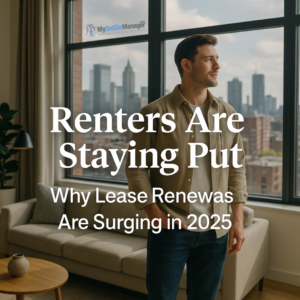The U.S. rental market is witnessing a notable shift—renters are renewing their leases at historically high rates. With soaring housing prices, high interest rates, and economic uncertainty, many renters are choosing to stay in their current homes rather than face the cost and hassle of moving. According to a recent Bisnow article, turnover rates for some of the country’s largest multifamily landlords have dropped to levels not seen in years.
But what’s really driving this “stay put” trend? And what does it mean for both tenants and landlords? Let’s take a closer look.
1. Lease Renewal Rates at Record Levels
Historically, nearly half of apartment renters move when their lease is up, driven by reasons such as job relocations, better amenities, or lower rents elsewhere. However, in 2025, this is no longer the case:
-
Equity Residential, one of the nation’s largest REITs, reported a turnover rate of only 7.9% in Q1 2025—an unprecedented low.
-
Other major landlords, including Camden Property Trust and Essex Property Trust, also saw turnover rates between 30% and 35%, well below the historical average.
This sharp reduction in mobility is a sign that many renters are finding it both financially and practically smarter to stay where they are.
2. Why Renters Are Staying Put
There are multiple factors behind this rise in lease renewals:
a) High Mortgage Rates and Low Housing Inventory
The dream of homeownership has become increasingly elusive. Mortgage interest rates remain above 6.5%, while housing inventory across the U.S. remains tight. For many, buying a home is simply out of reach, forcing them to rent longer.
b) Rent Stabilization vs. New Lease Increases
Renewing an existing lease is often cheaper than moving to a new property. New rental agreements frequently come with higher rates, while landlords are sometimes more willing to offer moderate increases for current tenants to keep occupancy levels high.
c) Economic Uncertainty
Inflation, rising costs of living, and fears of economic slowdowns are causing renters to avoid large financial risks. Moving to a new place often means higher upfront costs—security deposits, moving expenses, and application fees—which can easily add up to thousands of dollars.
3. The Landlord’s Perspective
High lease renewal rates aren’t just beneficial for tenants—they’re great for landlords too.
-
Lower Turnover Costs: Property owners save between $750 to $1,800 per unit when they avoid turnover-related costs, such as repainting, repairs, cleaning, and marketing vacant units.
-
Steady Occupancy: High retention means fewer vacant apartments and more consistent cash flow.
-
Tenant Relationships: A stable tenant base fosters better relationships and less wear and tear on units compared to frequent move-ins and move-outs.
4. The Tenant Advantage
For renters, staying put has its perks:
-
Avoiding Moving Costs: The expenses tied to relocation—truck rentals, hiring movers, and paying new deposits—are eliminated.
-
Negotiating Power: Tenants who have a good history with their landlords often have more leverage to negotiate smaller rent increases.
-
Stability and Community: Staying longer means building familiarity with neighbors, local amenities, and community routines.
5. Broader Market Impacts
The surge in lease renewals also reflects larger shifts in the U.S. housing market:
-
Slower Apartment Turnover: With fewer people moving, some landlords are seeing reduced demand for new leases, which could influence rent growth trends.
-
Age Demographics: Baby boomers and millennials are driving long-term renting, while even Gen Z renters are staying longer than expected due to affordability issues.
-
Urban vs. Suburban Trends: In urban markets where housing prices are steep, retention is particularly high, while suburban and Sunbelt regions are seeing modestly higher mobility thanks to slightly more affordable options.
6. Will This Trend Last?
There’s a strong chance that this renter “lock-in” trend will continue in the near term. However, the record-high construction of new apartments in 2023 and 2024 is beginning to create a wave of new inventory. As more units enter the market, rental prices could stabilize or even drop in some regions, potentially enticing more renters to consider moving.
Still, unless mortgage rates and home prices fall significantly, renters will likely continue prioritizing lease renewals over risky relocations.
Conclusion
The U.S. rental landscape in 2025 is defined by a sense of caution. Renters are staying put not just to avoid costs, but also to seek stability in an unpredictable economy. Landlords, in turn, are reaping the rewards of lower turnover and steady occupancy rates.
For renters, the key takeaway is this: renewing your lease could be the smartest financial move right now—especially if you can negotiate favorable terms. And for landlords, maintaining strong relationships with current tenants is more important than ever.
Source: Renters Locked Out Of Housing Market Push Apartment Renewal Rates To New Highs — Bisnow National

